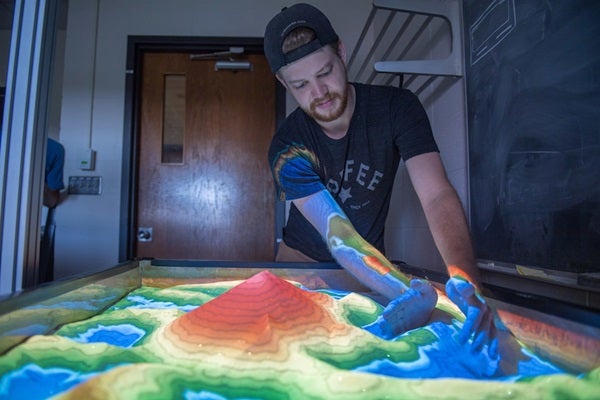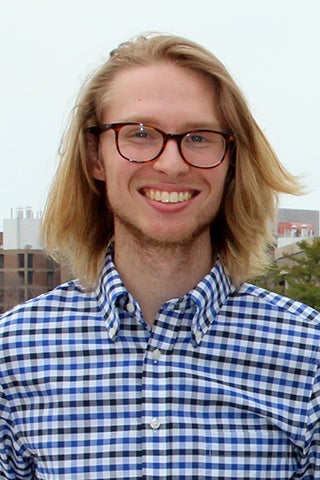To use Gravbox, one first sculpts an environment out sand, then a computer program projects a moving particle onto the terrain. The projected particle simulates how an object (such as a comet or space probe) would travel through the imagined landscape.
“Gravity is the dominant force and we really don’t have a good representation of that right now,” said Jacob Isbell, one of the undergraduates who worked on the project, in an interview with WKOW. “So we’re trying to help bridge that gap and give people a better sense of what’s happening in the background of the universe.”
On the first day of his Introduction to Astrophysics course in the fall of 2016, Fu outlined the concept for Gravbox to his 10 students, ranging from sophomores to seniors. At first, “it seemed impossible,” said Sadie Moore, a senior majoring in physics and astronomy. However, the students were undeterred. “The idea was awe-inspiring,” she said.
Equipped with both funding and inspiration, the students split into three teams and got to work.
The first team was responsible for both designing and building a tabletop structure capable of holding 200 pounds of sand. With the help of Head Machinist Brian Busch, the students built a wooden base to which they mounted a projector stand. The sturdy base also included a slide-out cabinet to house a computer, cables, and a tablet.
The second team concentrated on creating an algorithm that calculates the gravity at a given point in the sandbox, and then uses that calculation to guide a projected object’s motion through the environment. Initially, after a user would move some sand (thereby redistributing the gravity within the box), the algorithm would take three minutes to recalculate the object’s motion. Over the course of a year, the students were able to reduce that time to less than one second.
Though all three teams worked tirelessly on Gravbox over the 2016-17 academic year, by the time classes ended, the system still had some glitches. This prompted a number of the students to stick around campus and continue working on the project through the summer break, eventually ironing out all of the kinks by fall.
“There’s that moment of recognition that what you’ve been working on has actually paid off in a finished product,” said Sophie Deam, a senior majoring in physics and astronomy and member of the algorithm team.
“It was engaging that in a sense you had to work as a team,” said Mason Reed, a senior physics and astronomy major. “That gives you perspective for what working in a research group would be, figuring out how to work together, and finding the right balances.”
Jacob Isbell demonstrates how Gravbox, an augmented-reality sandbox, works.
Nicholas Tomlonovic
“I think it’s unbelievable,” says Fu. “The students built the whole thing from scratch.”
Though the Gravbox initially started as a fun class project, moving forward, Fu says, the Gravbox will be used to illustrate fundamental principles in physics, such as how gravitational dynamics affect the distribution and shapes of stars, galaxies, and more. Fu and the students also have plans to share the AR sandbox with schools, amateur astronomy clubs, and museums.
However, the goal of Gravbox is not to make money. During the 231st meeting of the American Astronomical Society last week, Isbell emphasized that he wants the Gravbox to serve as an interactive learning tool for many others, both young and old.
“Essentially, we want all of this to be open source, so anyone can go to our website, download it, look at the hardware, the specifications they need, then they can go and try to build their own,” said Mason Reed, a senior physics and astronomy major, to The Daily Iowan. “They can use our baseline model and see what they can do with it, be creative, and build their own.”












